
Covering the War
March 6 - Nov 21, 2015
American Quilts in Times of Conflict

Since the American Revolution, when men marched off to war women mobilized at home. They raised money for relief, fed their families on limited rations, rallied patriotic spirits, celebrated victory, advocated for peace, built weapons, rolled bandages, comforted the wounded and mourned the dead: Women “covered” many of these activities with quilts.
With quilts from the Mexican-American War in the 1840s through Operation Iraqi Freedom in recent memory, Covering the War spotlights enthusiastic patriotism and voices for peace; honor for highly ranked officers and enlisted men and women; public support for the Red Cross and private efforts to recover a normal life. The quiltmakers’ voices echoing through these quilts inform us how they experienced the political, economic, psychological and mortal impacts of war. Their quilts remind us that war’s traumas and triumphs are not limited to the battlefields but make their way home, too.